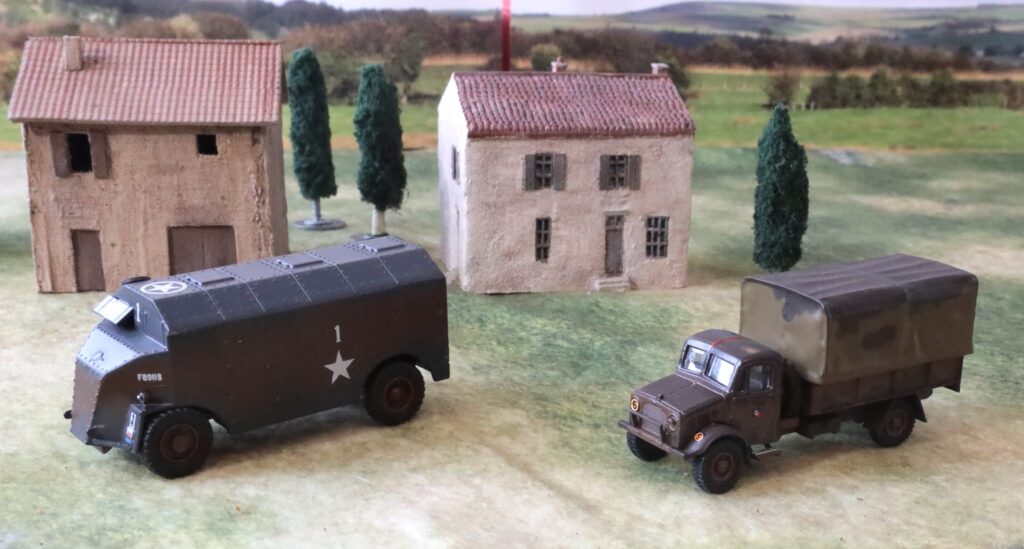
Making up and painting models from kits and castings is a faff. What about buying die cast models ready assembled and painted? A bit more expensive, but not that much, and less trouble. For my most recent project I decided to try a couple of models from Oxford Diecast. These were a Bedford OYD 3-ton truck, and a Dorchester Armoured Command Vehicle (ACV). The former was to provide a bit more variety to my transport (dominated by Bedford QL trucks), the latter to act as brigade command vehicle for my British at Medinine and doubtless subsequent scenarios. Here’s what I found.
Firstly these are marketed as collectors’ items and not as wargames models. They come in nice plastic display boxes, screwed to the base. For tabletop use you have to unscrew them – and you then have the display boxes to throw away or repurpose (or leave hanging around while you try and think of how you might repurpose them). Once out, the models are nicely detailed and beautifully finished. They also handle nicely. The Bedford even rolls one its wheels. Unfortunately the Dorchester’s front wheels don’t fit properly and are jammed against the wheel arch. They are quite small – true 1/76 scale I would guess without measuring them. Alas I’m finding that “20mm” models come in a range of scales. If the 20mm is meant to come up to eye level – itself a bit of a scale creep definition (it should really take you to the top of the head) – then the scale should be about 1/80. All 20mm products are bigger than this that I have seen. Plastic Soldier has 20mm in the range description, and 23mm in the instruction leaflet (about 1/70 in my book) – and maybe a bit bigger even than. So these models are at the smaller end of the range, but consistent with Airfix vehicle kits, old and new, for example, and models from the likes of Milicast and SHQ.
Here’s the OYD next to my Airfix QLD to give an idea of size:

One obvious difference is that the die cast models come with windows – though in fact I could have put these into the QLD in this case. Most wargames models either have the windows completely open, or, now more common in the age of 3-D printing, moulded solid. There is no driver model, and adding one would mean disassembly and potential damage. You would also struggle to find space.
The next issue is finish. These models are painted in authentic colours (they match precisely to the colours in my reference book on WW2 colours). That means there is no attempt to lighten them up to replicate the scale effect, which is something I like to do. This is a complicated topic with “that depends” type answers – it basically means that they look best representing originals in in strong light, and this is clearly the standard for display models. On the wargames table they will be a bit dark. There is also a slight off-matt finish – appropriate for a parade ground rather than the battlefield. The tilt on the Bedford is plastic, and the finish a bit plasticky. The decals are lovely and intricate, going down to serial numbers, etc, which I don’t bother with.
So how about incorporating these vehicles into my 1943 tabletop army? Take the truck first. This is modelled on a vehicle in the 15th (Scottish) Division in the UK in 1943 in the artillery. The paint scheme is fine for 1943 First Army in Tunisia. And second-line vehicles might well not be repainted for later campaigns. The divisional marking is not correct – but this can be removed rather than replaced, as these aren’t very 1943 in theatre. Perhaps it should have a roundel on the roof for air identification (the white stars were not used by the British in this theatre, even later in the war). Removing the divisional decal would be quite delicate work, though – but I do have some very fine sandpaper. To integrate with my army at large the model will need to be weathered – though this feels a bit sacrilegious on such a nicely finished model. I think this would take the form of a little white oil paint, brushed very thin, which would help lighten it up, as well as representing slightly uneven discolouration. And then dusting with powdered pastel. I don’t think there is the need for a wash.
The Dorchester is another matter. This represents a vehicle in use by the Polish Armoured Division in Northwest Europe in 1945. In fact the camouflage scheme is similar to the Bedford (brown and blue-black) and OK for 1943. But unlike the trucks, these vehicles were nearer the front line and surely would have adopted one of the standard or ad-hoc camouflage schemes. This might be the Desert Pink (appropriate for Medinine), Light Mud (Sicily and Italy) or plastered with lighter coloured paint ad-hoc (First Army Tunisia). But it does look as if I should repaint this, using the airbrush. That gets round the issue of the decals, which would be overpainted rather than sanded off. At least I don’t have to worry about the windscreen and windows.
So the models will need some work to be table-ready, and I should reserve my final judgement. I don’t see myself buying many more, though.